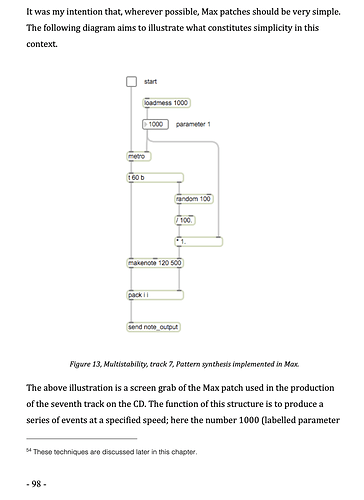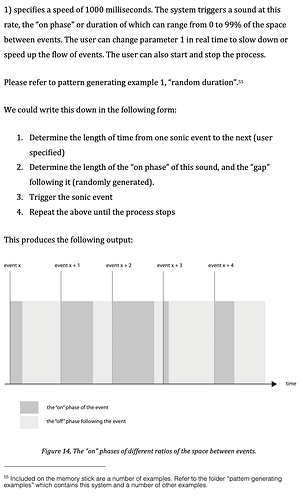Thanks for confirming that, Tamiko, I’ll need to investigate further what’s going on with that project
Maybe it has to do with the newer versions? I’ll try and test it when I get a demo of ver 12.
I like TidalCycles its not a physical gear but a very powerful sequencer/synthesizer for generative/algorave music
Mike Hodnick used TC for control Analog Rytm, It’s incredibly cool how he rediscovers his favorite gear. Check out his channel for implementation examples.
He is a Genius, you could pick any album… IMHO
OP said they didn’t want to do any programming (in Max), so I doubt Tidal cycles will appeal…!
oh i don’t like max, his visualization frustrates me. But Tidle in this sense can be much more practical. i am very far from programming and this tool turned out to be very clear to me. i would call this menu a trigconditioning on steroids
the Tidal video tutorials (by the creator, Alex??) are great and I followed them for a while, but ultimately im really not a programmer outside of Max, even tho I wish I could grasp all that stuff. I think my point was that if the OP is put off by using Max, which is relatively speaking very approachable in terms of programming, then something like Tidal will likely not be appealling. It’s a good suggestion tho, have heard/seen some great stuff programmed in TC.
Numerology, cirklon and maybe also the vector (hardware -limited- version of numerology)
This is just an exchange of experience, but you are partly right. Any non-trivial ideas always require effort.
Btw, if anybody’s after Structure & Synthesis but can’t find a copy, it’s pretty much an expanded version of his PhD thesis, which can be read here Research Portal
fwiw, the publisher (urbanomic) recently released a digital copy of the book for purchase for all those who missed out on the print version. it can bought from their site.
in the recent cycling74 office hours with him iirc he talked about how he is possibly collaborating on a new edition with the publisher (rather than a reprint) but from what I gathered I would not hold my breath for it appearing any time in the near future.
Both Cirklon and M8 have sort of aux evens that can control global events like tempo but also mess with ratcheting in various ways.
Metropolix has the standalone case now and you can essentially ignore the CV side of it if you want, it has the ability to use different divisions on each lane so you can do something like set up a mod lanes that moves forward once every 8 steps of the note sequence and changes the pulse count/pulse division/clock division of the sequence on each step, not as granular as sequencing tempo but it is pretty granular still and lets you have other things still running at the master tempo and what not. It can also self modulate BPM if you have it as the master.
Actually this looks freaking awesome and looks like it would work way better for my brain than Max! It looks quite intuitive to code in and I can learn a lot from Mike’s videos. And working in a separate environment from a DAW works well for me too.
I’d just have to work out how to set the MIDI up as Mike doesn’t cover this.
EDIT: I’m not sure I have the skills to even get MIDI set up…
SuperCollider + SuperDirt + TidalCycles = ![]()
You can edit steps within patterns.
True, but it can also be an invaluable learning tool on the way to learning how to do it yourself.
My fav Mark Fell’s work is when he was in SND, especially the first three albums (extended versions of Tplay, Newtables and Travelog - which were sequenced in Cubase and Logic with what seems to be hw quirky synths and drum machines) and the last two big SND releases (4,5,6 and Atavism - which were sequenced with Max + some hw and sw FM synths).
Of his solo works i like Multistability and Ten types of elsewhere the most! (Max works).
In some of his video interviews he explicitly showed his Max patches and how they work.
From a Mark Fell interview… so basically human midi programming triggering samples.
“Probably 90% of the first SND stuff was all done on one sampler (EMU6400) and the thought of adding to that equation just always seemed wrong.”
“So the first couple of SND albums were all done in Cubase or Logic and constructed quite carefully, not using any kind of algorithmic processes at all”
Was just posting this, and then Discourse let me know it was a double-link!
It contains a few diagrams of the Multistability patches. Here’s track 7, on page 98:
There’s also a very good interview from Tom Hall at Cycling '74. Unfortunately, I remember watching this live and there were sound issues when Mark tried to show off an example patch, but the visuals should still be there: https://www.youtube.com/watch?v=Io_1EL8jo70
In general, his Max patches are significantly simpler than the monster Autechre patches that have floated around the internet, or even a lot of M4L sequencers. They tend to be simple ideas executed very well.
The Multistability patch above is a good exercise for porting over to an environment of your choice. If I were to do it in VCV, for example, I would use four modules: a clock generator, a gate width modifier, a random generator, and a MIDI output. Here’s what I would use for the gate width modifier: VCV Library - VCV Gates
Take a steady clock, and plug it into the Gates input. Use the clock to also trigger a random generator and modulates the LENGTH parameter on Gates (Maybe add an attenuator to keep the range useful if the random generator doesn’t have a level/amplitude parameter). Plug the Gates output to the MIDI output.
For those who own one: Both Nord Modular’s are very nice for these kind of sequences. A G2 is even better because it can send Midi to other gear.
Thanks to this thread i’ve been revisiting those Sensate Focus releases. Solid stuff.




